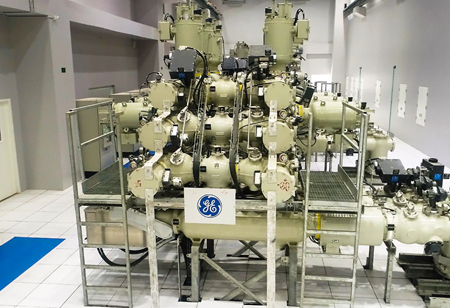CtrlS has announced deployment of Asia’s largest Gas Insulated Substation (GIS) in Mumbai. The state-of-the-art gas insulated substation (GIS), is currently equipped with a whopping 300MW and can scale up to 700MW and backed by three different sources and diversified paths ensuring 100% availability of power at all times, thus ensuring powering the two million square feet CtrlS Datacenter Campus spread across 10 Data Centers.
CtrlS GIS facility has very limited sensitivity to environment, humidity. It is highly corrosion resistant, seismic resistant, enjoys an operating life of greater than 50 years, with no maintenance requirement for 25 years. It is also protected against aggressive environmental conditions. Thus the facility will now help businesses collocate their high density IT infrastructure combined with seamless scalability to address their growth requirements.
The GIS deployed by CtrlS is one of the first large scale deployment in Asia powered by 3 line configuration (N+N+1) and has 3 source substation backed by 2 or more substations. Thus, providing highest reliability. CtrlS is equipped to deliver large capacities such as 100 MW of power to any customer in 15 to 18 months.
Gopalakrishnan, Managing Director, GBCI, Southeast Asia and Middle East, said, “CtrlS deploying a 300 MW gas insulated substation (GIS) is a path breaking phenomenon in the industry. This is the first of its kind deployment of power infrastructure by any data center company in the Asia Pacific region.
What is more interesting is the fact that CtrlS has planned ahead by ensuring that the GIS can be scaled up to 700 MW. Combined with its planned addition of 2 million green data center footprint in Mumbai the company is now poised to address the needs of high-density racks. Through this investment, CtrlS has again placed sustainability and efficiency at the core of its operations to provide its customers with world-class green data centers in India. Demonstrating its unparalleled commitment to sustainability, Ctrls Mumbai received its LEED Platinum certification under LEED v4 O+M in 2017 and has registered their second project within the same campus for LEED under LEED v4 BD+C in 2019.”
The Gas Insulated Substation (GIS) technology originally began in Japan in the 60’s, where there was a critical need to develop substations. In the US, only about 2 to 5% of new substations are constructed as GIS. The Air insulated substation (AIS) leads to wastage of space, suffers from seismic instability and poor dielectric strength of air.
“The deployment of 300 MW gas insulated substation scalable to 700 MW is our commitment to the industry as we continue to address the growing needs of hyperscalers, telcos, BFSI, healthcare, gaming, and new age companies. We stay committed to adopting innovative approaches to serve the unmet needs of our customers, said, Sridhar Pinnnapureddy, Founder and CEO, CtrlS Datacenters.”
The salient features of CtrlS deployed GIS are: Protection system such as over voltage, Under Voltage, short circuit, instantaneous, master trip, intra trip, axillary etc and more 40 protection systems of the entire GIS infrastructure is built in N+N architecture The GIS facility has lighting arresters, dedicated BCU (Bay control units), BPUs (Bay protection units) for each bay. It has alarm systems and is fungi resistant. It has aluminium casing and an ethernet interface. The GIS has a Windows based monitoring system. The GIS has a gas leak detector. All the cables laid are of 1100V grade FRLS armoured PVC copper cables conforming to IS 1554.
CtrlS, that is continuing its tradition of rolling-out innovative solutions to its customers, has successfully deployed a new generation 300 MW gas insulated substation (GIS) with unmatched levels of reliability, performance and security through real-time monitoring, interoperability and automation.
The company stays committed to delivering best-in-class solutions as it expand its hyperscale data center footprint to 6 million in the next 18 to 24 months across Mumbai, Hyderabad, Chennai, Kolkata, besides enhancing its edge data center network in tier-2 and tier-3 cities in the country.
